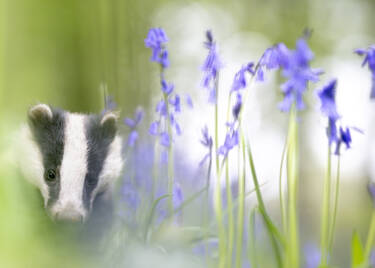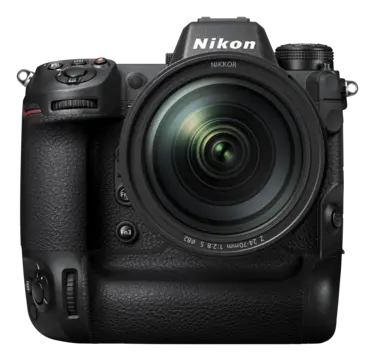Using Plena for wildlife

Discover how a lens made for portraits helped Rachel Bigsby transform a quiet woodland encounter into one of the most magical moments of the BBC’s Wild Isles
“Photographing badgers is like chasing ghosts,” says wildlife photographer, filmmaker, presenter and Nikon Creator Rachel Bigsby, who spent years observing a single badger clan in a Sussex woodland, earning their trust through quiet persistence. Her long-time goal of photographing them during the fleeting bluebell season was finally realised for the BBC’s Wild Isles, using the most unlikely lens: the NIKKOR Z 135mm f/1.8 S Plena. “It performed faultlessly, truly. The way it handled the low light was exquisite, but what stood out most was how it rendered the woodland. The Plena’s bokeh feels effortless and immersive. It was not just soft, it was romantic. Bluebells turned into watercolour washes. Light danced in circular whispers. The badger became part of a painting rather than merely the subject of a photograph. It elevated my imagery from documentation to visual poetry that made the badger feel like a mythical creature, caught in a brief and beautiful pause between dusk and dark.”

Z9 + NIKKOR Z 135mm f/1.8 S Plena, 135mm, f/1.8, 1/2500 secs, ISO 4000, ©Rachel Bigsby
Life through a new lens
Typically reserved for portraiture, Rachel says the decision to team the Plena with her Z9 was born out of necessity as well as curiosity. “The f/1.8 aperture offered an answer to the low-light challenges I faced at the badger sett, and the lens’s beautiful bokeh hinted at a new, creative way of photographing,” she explains. “For too long, I believed that the pinnacle of wildlife photography was a tight portrait, a close-up, a stare. But the Plena changed that. It re-taught me to see the animal within its world, not apart from it. With this lens, storytelling became layered, creature and habitat woven together in harmony.”
Using the Plena didn’t just transform Rachel’s imagery, which in the past has been featured by leading platforms such as National Geographic, New Scientist, BBC’s Springwatch, Countryfile, WWF and the RSPB, it also changed the way she photographed. “At first, the limitation of not being able to reach distant subjects felt like a disadvantage. But then I realised it was a gift,” she explains. “It forced me to rethink. To move. To see in new ways. I wasn’t just documenting behaviour anymore. I was composing stories. It was liberating to be nudged out of my comfort zone and invited into a more mindful, intentional style of photographing.” And it wasn’t only the tech that initially proved challenging, as Rachel reveals nature had its own obstacles. “The bluebell season is breathtaking, but fleeting,” she says. “There’s a mere whisper of time when the flowers bloom and the badgers stir before darkness swallows the woodland whole. The hurdles were steep: low light, unpredictable emergence times and no control over the scene, subject or weather. But therein lay the magic – surrendering to the wild, adapting to its rhythms. I couldn’t direct or dictate anything. I had to listen, learn and wait. And in doing so, the forest revealed something far more poetic than anything I could have planned.”
After more than four years quietly observing the same badger clan, Rachel’s connection to them has moved far beyond photography, as she claims the experience didn’t just hone her technical skills but also reshaped her entire perspective. “It taught me more than patience,” she reveals. “It taught me reverence. To finally share their story was an overwhelming blend of gratitude and responsibility. These badgers had long been my secret, nocturnal neighbours whose lives unfolded in summer sunsets and silent moonlight, hidden from the world but becoming my whole entire world. To illuminate their story on a national stage, in a David Attenborough documentary no less, felt like finally giving them the recognition they have always deserved. It was a moment where time, devotion, and deep love for these misunderstood creatures converged into something tangible, a visual ode to their quiet resilience and all that they endure.”


From villain to victim
While Rachel’s star animal is undeniably on the rise, so too is awareness for the animals she’s so tenderly snapped, as her evocative images of the woodland creatures are helping to reshape the narrative around one of Britain’s most vilified mammals. “Those images are more than just photographs to me, they’re a manifesto,” she explains. “They quietly defy the centuries of persecution badgers have endured. These animals are relentlessly scapegoated and yet, in those frames, all you see is serenity. It’s a portrait of coexistence; an ancient woodland awash with bluebells, a badger bathed in light, existing in peace. That image represents what our wild spaces could and should look like. But they don’t. More than 230,000 badgers have been culled during the last decade, and yet this clan, by sheer chance, is outside the cull zone. I don’t say ‘fortunate’, because badgers are anything but. But these photos are a glimpse into a parallel Britain, one where nature is left to bloom and breathe.”
While badgers might not be everyone’s favourite animal (especially among farmers, given their role in spreading bovine tuberculosis to cattle and damaging crops), it was a childhood glimpse of one that sparked Rachel’s passion for photography, and what began as a quiet obsession soon became a full-blown calling. “My work is led entirely by love,” she says. “I only photograph the species I feel deeply for. That connection is my secret strength, it’s what lets me see what others miss. I notice the way raindrops gather on oily feathers, the rhythm of flight, the nuance of a call. My obsession becomes my intuition, and intuition is everything in this line of work.”
From badgers to birds
After photographing the badgers and developing a penchant for using the Plena for wildlife, Rachel took the lens north to document seabirds on a remote island on the edge of the Arctic. “Hornøya is an island where seabirds perch in blizzards and cliffs dance with life,” she explains. “I used it to film puffins, shags, razorbills and guillemots in the snow. The depth of field was utterly cinematic; seabirds framed in flurries, snowflakes softly melting into the background. Ultimately the Plena has become a permanent part of my kit, not just for its technical prowess, but for how it shapes my creative vision.”

Z9 + NIKKOR Z 135mm f/1.8 S Plena. 135mm, f/1.8, 1/2500 secs, ISO 4000, ©Rachel Bigsby
Rachel’s wildlife photography top tips
1. Master low light
“I lean on manual focus when light fades, and I embrace slower shutter speeds when the subject allows for stillness, or sometimes I’ll use a tripod. I keep my ISO flexible and trust the Z system’s incredible noise performance. But, more than anything, I trust the lens.”
2. Move with a prime
“Be brave. Prime lenses challenge you to think, to move, to truly compose. Embrace the limitations, they’re actually invitations. Let go of the obsession with proximity and instead fall in love with storytelling. Wildlife is more than sharp eyes and feathers. It’s about the space, the light, the story surrounding it.”
3. Spend time in the field
“Start simple. A mirrorless camera with a mid-range telephoto lens (such as a 70-180mm, or a DX 50-250mm) can do wonders. Focus on understanding light, behaviour and composition before you chase kit. To a beginner, time in the field is worth more than the most expensive lens.”
4. Be still. Be silent.
“Wildlife reveals itself when we stop trying to control it. I study wind direction, camouflage my scent and move like I belong to the forest floor. Sometimes, I just sit still, letting the wild forget I’m there. The goal isn’t to get close, it’s to become invisible. I never assume the animal is unaware, because they rarely are. To suggest so would underestimate their intelligence and sensitivity. My focus is always on not disturbing them.”
5. Learn behaviour
“Understanding your subject makes you a better storyteller. I always prioritise ethics above imagery. That means understanding behaviour deeply enough to recognise even the subtlest signs of stress. I stay conscious of natural rhythms (feeding, grooming, resting) and monitor whether my presence alters them. Over time, working with the same individuals or populations, I begin to understand their unique tolerances. It’s a delicate balance, built on respect.”
Rachel Bigsby’s kitbag for this photoshoot:
Nikon Z9, NIKKOR Z 135mm f/1.8 S Plena, NIKKOR Z 400mm f/4.5 VR S, NIKKOR Z 70-200mm f/2.8 VR S, spare Z9 battery.
Benro Tortoise Columnless Tripod Carbon Fibre TTOR03C+GX25 head 3 section, Shimoda Action X V2 40L in Army Green, waterproof pull-on trousers for emergencies, mini first aid kit, and lens cloths.
More in Nature and Wildlife
Featured products
More from Rachel Bigsby

Unlock greater creativity












